Gio Ponti’s cut-out cathedral in Taranto deserves a resurrection
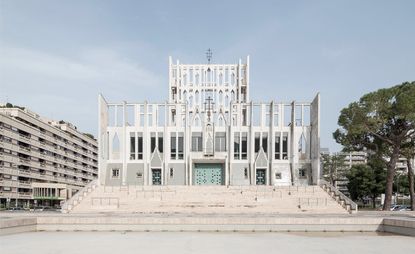
A run-down port city on the edge of Europe that has suffered from decades of industrial decline, and an iconic building designed by a world-famous architect at the peak of his career. The description may sound a lot like Bilbao, but where are the hordes of tourists and the booming economy?
The iconic building I’m referring to here is not by Frank Gehry but by Gio Ponti, the legendary Italian architect-designer best known for the Pirelli Tower in Milan and the ‘Superleggera’ chair, which he created for Cassina in 1957. Yet this is arguably the greatest work of his later years, and it deserves to be rescued from the obscurity into which it has gradually sunk since it was completed in 1970.
The city is Taranto, which sits beneath the heel of southern Italy. A major naval base, it has a remarkable history and a spectacular setting between a sweeping bay and the Mare Piccolo, an inland sea. Founded as a Spartan colony in the eighth century BC, it grew to become one of the biggest cities in pre-Roman Europe, but sadly, contemporary Taranto has seen its fortunes fade. Though it had a minor boom in the 19th century, in the 1930s Mussolini had a quarter of the ancient centre demolished to build a row of grim apartment blocks, and it was badly bombed in the Second World War. To add insult to injury, Europe’s biggest steelworks belches dust and dioxins into the air, giving Taranto the unenviable reputation of being one of the worst polluted cities on earth.
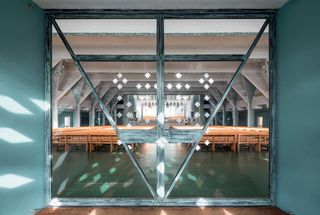
Looking from the bronze entrance doors through the low nave towards the altar.
Back in the 1960s, though, a mood of optimism, and the rapid expansion of the so-called Città Nuova to the south east, convinced the local archbishop, Guglielmo Motolese, that Taranto needed a new cathedral to supplement the small 11th-century basilica in the old town. The choice of Gio Ponti as architect might seem unusually enlightened, but Ponti was a deeply religious man and had already designed several churches in Milan. Not surprisingly, he jumped at the chance of building a cathedral and, between 1964 and the start of construction in 1967, he developed what is arguably his most complex and original plan.
The design of the Concattedrale Gran Madre di Dio, as it became known, was inspired by its maritime surroundings. In place of a central crossing tower, Ponti came up with the idea of a ‘sail’. A kind of belfry without bells, the full width of the nave and 40m high, it is built from two concrete walls just a metre apart, perforated with vertical slits and hexagonal openings, including what Ponti called a ‘door to the sky, opening onto the immensity and the mystery of space and time’. The west front follows this openwork idea, featuring a stripped-down version of a medieval screen, with Gothic arches replaced by triangular canopies. A stepped podium raises the cathedral above a piazza and a trinity of reflecting pools that symbolise the ocean, while sea-green floor tiles add an appropriately aqueous accent inside.
The interior is equally considered. Triple bronze doors lead to a galleried narthex and the wide, low nave, lit by a scattering of tiny hexagonal windows tucked between the V-shaped springers of the transverse vaults. Beneath the ‘sail’, where the crossing would normally be, the roof level rises dramatically, flooding the choir with light from a full-width window immediately above but hidden from the nave. Five steps higher than the nave, the choir is flanked by two side chapels with galleries above, enclosed by three levels of arcades, their reveals and soffits painted in various shades of green. Stepped seating rises behind the futuristic winged altar, which is flanked by two freestanding columns supporting spindly crosses that also read as anchors – another nautical touch.

The nave, the choir, with the green-painted Bishop’s throne, and the side chapels. Ponti’s aqueous colour scheme has been refreshed over the years.
Early photographs of the cathedral show it on the edge of the city, surrounded by fields and olive groves. Sadly, this bucolic setting was not to last. Though Ponti intended the building’s stark outlines to be softened by lush surrounding gardens, with the ‘sail’ and the freestanding arches that frame the side doors designed specifically to support climbing plants, these plans came to nothing. Today, this masterpiece of 20th-century architecture is a poignant sight. Though the interiors have been maintained fairly well, the exterior is disfigured by graffiti and desperately in need of a lick of paint. Those idyllic olive groves, meanwhile, were long ago buried beneath blocks of 1970s housing, which surround the cathedral on three sides, while the back overlooks a rubbish-strewn car park.
Sophie Bouilhet Dumas, Gio Ponti’s grand-niece and (with Olivier Gabet and Salvatore Licitra) co-curator of a major Ponti show coming up at Paris’ Musée des Arts Décoratifs, believes it to be one of the architect’s greatest works. ‘Taranto Cathedral is the most accomplished expression of Ponti’s personal vision of a “pantheistic” religious art,’ she says. ‘It represents the achievement of an architectural dream of building an edifice merged with water, vegetation and air.’
In Bilbao, Frank Gehry’s Guggenheim Museum gave the city a new lease of life. Is it possible that a restoration of Ponti’s cathedral could do the same for Taranto? There are some promising signs. Late last year, a consortium that included ArcelorMittal offered £1.8bn for the city’s steelworks operator, in a deal that included a commitment to clean up the site and reduce emissions to environmentally acceptable levels. (The deal awaits a ruling from the European Commission.) Taranto has an ambitious new mayor, and there is pressure from local groups to improve the city’s image.
Admittedly, with a population of just 200,000 (greater Bilbao is over four times its size) and high unemployment, Taranto struggles to fund even basic services, never mind cultural icons. Yet the Guggenheim Bilbao was largely funded by the regional government, not the city. And surely the renovation of an architectural icon of European significance would be the perfect candidate for European funding? Watch this space – but, in the meantime, go and see.§
As originally featured in the June 2018 issue of Wallpaper* (W*231)
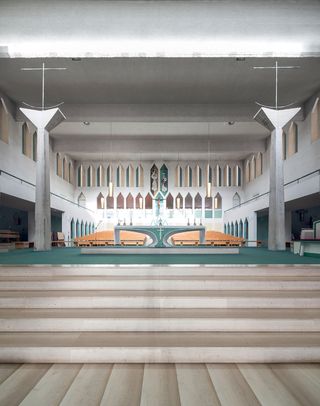
Ponti’s futuristic winged altar flanked by concrete pillars supporting stylised anchor crosses of his design. The paintings in the arcade behind the choir are also by Ponti
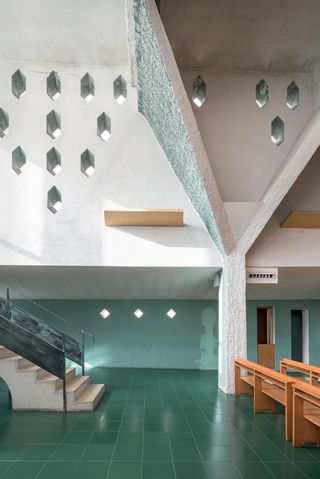
Tiny hexagonal windows throw beams of light into the nave and across the sea-green tiled floor. The building has suffered because tight budgets meant Ponti had to use cheap brick and concrete, which hasn’t aged well
Wallpaper* Newsletter
Receive our daily digest of inspiration, escapism and design stories from around the world direct to your inbox.
-
 As London’s V&A spotlights Mughal-era design, Santi Jewels tells of its enduring relevance
As London’s V&A spotlights Mughal-era design, Santi Jewels tells of its enduring relevance‘The Great Mughals: Art, Architecture and Opulence’ is about to open at London’s V&A. Here, Mughal jewellery expert and Santi Jewels founder Krishna Choudhary tells us of the influence the dynasty holds today
By Hannah Silver Published
-
 London bar Bauhaus Warehaus is a factory by day, drinking den by night
London bar Bauhaus Warehaus is a factory by day, drinking den by nightMixologist of the moment Remy Savage shakes up the world of cocktail-making with a hardworking sibling to A Bar with Shapes for a Name, his Bauhaus-inspired bar enterprise in east London
By Neil Ridley Published
-
 Copper piping turns contemporary lighting: the twist in JamesPlumb’s designs at Gallery Fumi
Copper piping turns contemporary lighting: the twist in JamesPlumb’s designs at Gallery FumiDesign studio JamesPlumb presents sculptural copper chandeliers and floor lights in its solo exhibition 'Rooted' at Gallery Fumi (until 25 January 2025)
By Ali Morris Published
-
 A floor made of tomato skins? Welcome to the Mutti Canteen by Carlo Ratti in Parma
A floor made of tomato skins? Welcome to the Mutti Canteen by Carlo Ratti in ParmaMutti Canteen by Carlo Ratti is a new, environmentally friendly foodie piece of architecture within Parma's green countryside
By Ellie Stathaki Published
-
 A new village chapel in the Czech Republic is rich in material and visual symbolism
A new village chapel in the Czech Republic is rich in material and visual symbolismStudio RCNKSK has completed a new chapel - the decade-long project of Our Lady of Sorrows in Nesvačilka, South Moravia
By Jonathan Bell Published
-
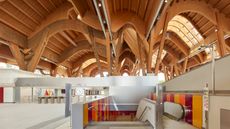 Naples Central Station boasts a wavy, wooden signature roof that is dramatic and sculptural
Naples Central Station boasts a wavy, wooden signature roof that is dramatic and sculpturalNaples Underground Central Station by Benedetta Tagliabue is a work of art that’s inviting and vibrant, matching its dynamic context
By Ellie Stathaki Published
-
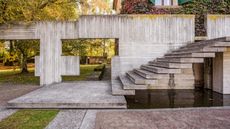 ‘Carlo Scarpa: The Complete Buildings’ is an essential tour of the Italian master’s works
‘Carlo Scarpa: The Complete Buildings’ is an essential tour of the Italian master’s works‘Carlo Scarpa: The Complete Buildings’ is the perfect book for architecture enthusiasts
By Jonathan Bell Published
-
 New Aesop Milan store is a haven of beauty and tranquillity
New Aesop Milan store is a haven of beauty and tranquillityThe latest Aesop Milan store to open is a hub of wellness, beauty and tranquillity in the Italian metropolis
By Ellie Stathaki Published
-
 A contemporary Istanbul mosque offers a take on tradition
A contemporary Istanbul mosque offers a take on traditionTurkey's Degostudio crafts this Istanbul mosque as a new, functional space for worship with accessible facilities
By Feride Yalav-Heckeroth Published
-
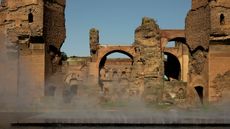 A new water mirror casts a misty veil over ancient Roman baths
A new water mirror casts a misty veil over ancient Roman bathsArchitect Hannes Peer reveals a water mirror in Rome – an immersive architectural installation at the heart of the ancient Baths of Caracalla
By Ellie Stathaki Published
-
 Modernist architecture: inspiration from across the globe
Modernist architecture: inspiration from across the globeModernist architecture has had a tremendous influence on today’s built environment, making these midcentury marvels some of the most closely studied 20th-century buildings; here, we explore the genre by continent
By Ellie Stathaki Published